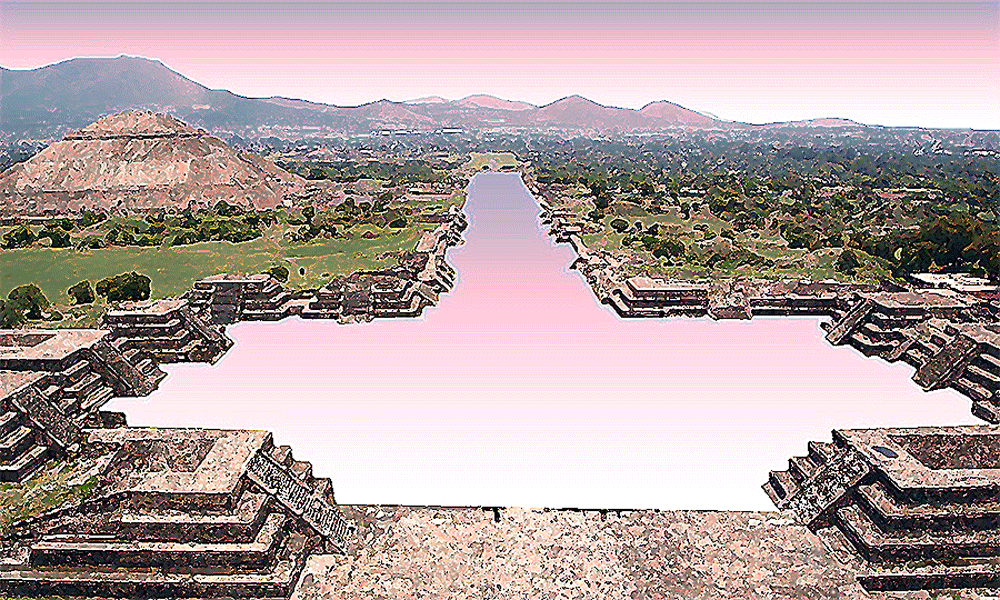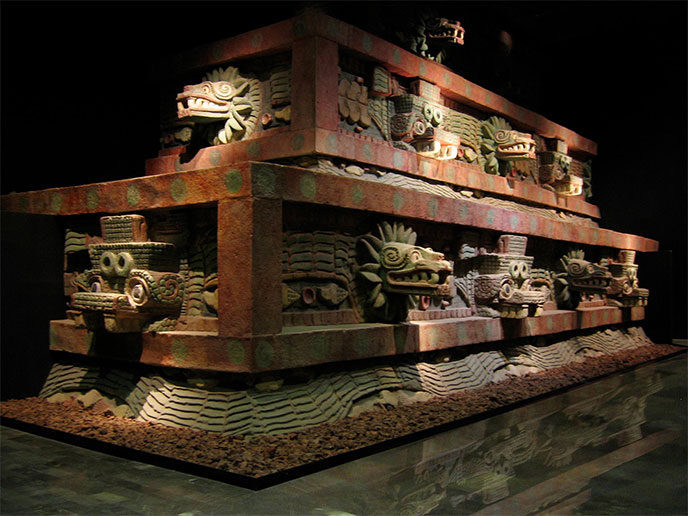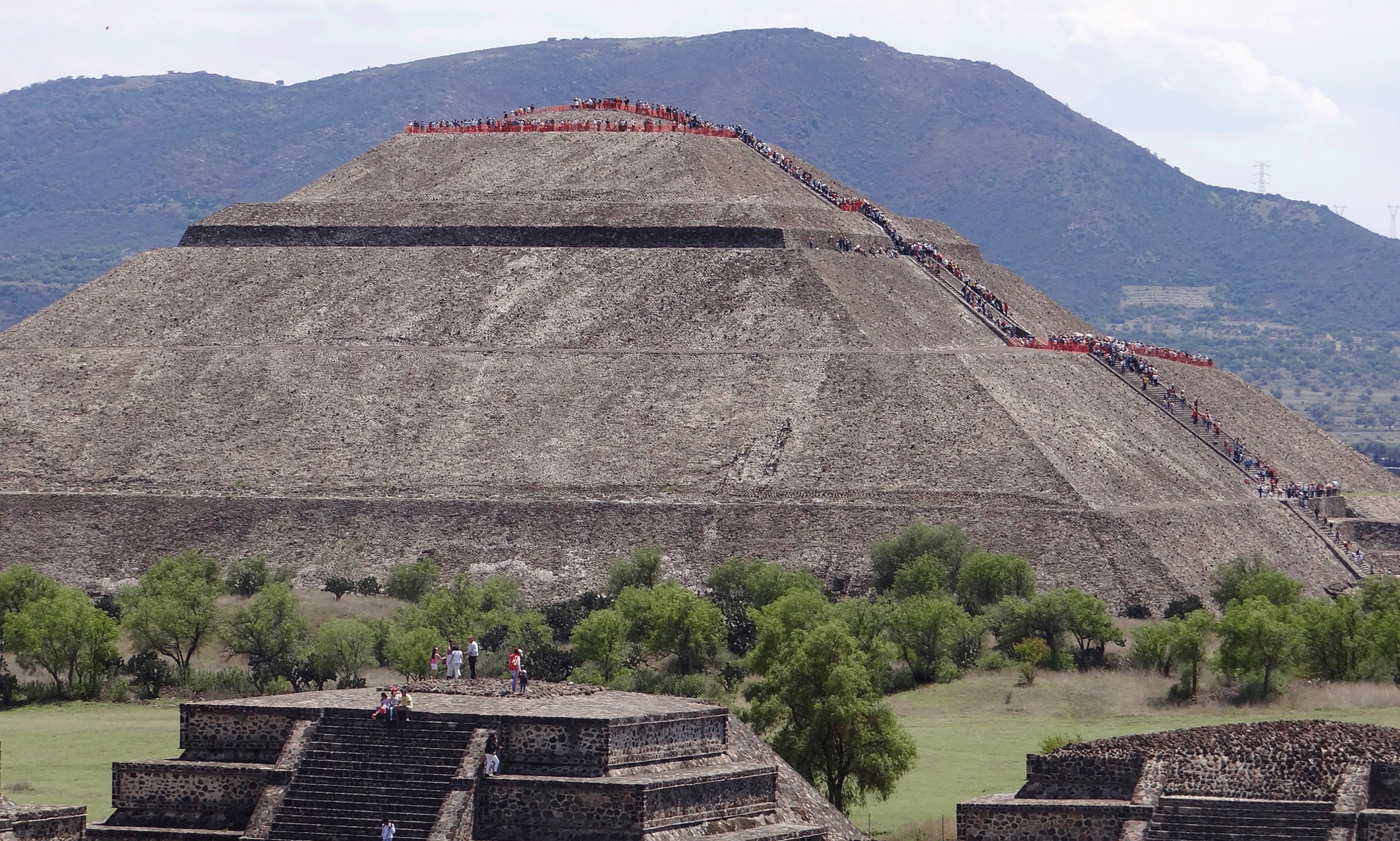
In Nahuatl, Teotihuacan means the city of the gods, or rather the city where one becomes gods. Difficult to be more explicit. This vast monumental complex with an uncertain origin was one of the first lightning traps, a sacred architectural complex where novices were awakened by fire from the sky.
Teotihuacán was for a long time the largest city in Mexico and the capital of the largest pre-Columbian empire. Two large avenues oriented north-south and east-west divided the city into districts. The old city, built according to a very precise grid, stretched over more than 20 km2.
When did this beautiful architectural ensemble date? The question is not unanimous. According to archaeologists, the pyramid of the sun was built in -150. The rest of the city was, for the most part, built between 250 and 600. For other authors, it is much older. Science cannot settle the debate.
Carbon 14 dating, questioned by physicists, cannot be applied to stones. Palinography either. No pollen deposited on a stone or on any shard of pottery will never give a date of construction, because it could be more ancient. Believing to be analyzing an organic matter left by the builders, we risk dating a tourist’s snack.
In their too recent dating, our archaeologists obey a dogma which wants that no American civilization is prior to our cities of the Middle East. But this dogma is not scientific, on the contrary, it looks like archeology to a kind of sect with unbearable and racist ideas.
Recent archaeological discoveries under the pyramid of the sun confirm more than ever the thesis of a very great antiquity for this site.
Here as in Peru, in Turkey, in Egypt, and in other sites, it is advisable to postpone the dating that the oxydantthe fault is willing archeology imposes for fifty years.
Whatever its real age, the City of the Gods has exerted a great influence on all the other cultures of the sector. Its art and architecture can be found throughout the Mayan region, from the north of Yucatan to the bordering territory of Honduras and to the Pacific coast of Guatemala, passing through central Mexico.

The largest structures are characterized by the talud-tablero style, the inclined talud supports the vertical tablero with architectural ornaments or stucco paintings.The buildings were often whitewashed and painted in bright colors. Most of the city was made up of residential complexes, some of which contain elegant and refined frescoes. Still in the very questionable dating of archaeologists, the last period (150-450) of the history of Teotihuacán marks the climax of the city whose splendor reaches its maximum.
At that time its population counted 200,000 inhabitants. Its cultural and religious influence was considerable. The influence it had in architecture and the arts reached Guatemala and beyond. Other Meso-American civilizations imitated its peculiarities, as is the case with talud-tablero and ceramics. Traders and pilgrims crowded there during large ceremonies.
The city of the Gods was abandoned in the 7th century, for an unknown reason, and in a relatively brutal way. This is the whole history of the city of the gods as we are told by archaeologists and historians. But we must also be interested in what they did not tell us. After the official version – often stupid out of ignorance of the myths – developed by professional archaeologists, here is the real story drawn from local myths.
The ancient city of Teotihuacan in Mexico has been the holy city of magic, where neophytes went to obtain awakening by fire from heaven. We will see how. Teotihuacan or better Teo Ti Wakan, it is the City where men become god. Wakan means sacred or divine in native languages. The god of the Sioux is Wakan Tanka, the Sacred Spirit or Great Spirit.
150,000 years ago, hundreds of supermen built the biggest lightning trap on Terra — planet Earth. The precious lightning was then estimated at its fair value. The former gods knew how to trigger a rise of kundalini in a subject, ie awakening this subject thanks to a strange feature of lightning, the ball.
Lightning can kill or awaken, depending on the case. The Atlanteans knew how to curb lightning to channel its liberating potential; they burst the deadly lightning into balls of white fire which vibrated the drinking water to make a potion of long life. They have built lightning traps all around the planet. Abydos, Giza, Mycenae, Cnossos, Gavrinis, Locminé, Carnac, Stonehenge, Avebury, Petra, Uruk, Jerusalem, Machu-Picchu, Tihuanaco, Cuzco, Tula, Mahabalipuram, Yonaguni, the Maldives, Easter Island … The five continents have known this civilization and its unique obsession with becoming gods.
![Stonehenge Sun, photo by simonwakefield [CC BY 2.0 (http://creativecommons.org/licenses/by/2.0)], via Wikimedia Commons -- https://commons.wikimedia.org/wiki/File:Stonehenge_(sun).jpg stonehenge-sun-688po](https://eden-saga.com/wp-content/uploads/stonehenge-sun-688po.jpg)
We must imagine the City of the Gods as it was at its origin: the main axis called Avenue of the Dead was a large basin filled with a meter of pure water, jade or youth water. On site, it was noted that the construction of the avenue resembles that of a basin, rounded walls feet, joined stones, traces of bitumen. A system of pipes of which there are still visible traces renewed this water which, once vibrated by lightning, became a magic potion, for drinking and for irrigating market gardening. On the Pyramid of the Sun, a golden pyramidion played the role of lightning catcher.
In an adjoining lodge, apprentice gods awaited the heavenly blessing of the white fireballs. We noted the presence of mica at the base of the two pyramids of the Moon and the Sun. Mica is an insulating material widely used by electricians. Its role was to prevent lightning energy or vril from dissipating into the ground, like lightning does on the cables of our lightning rods. The ancients knew the energy of lightning too precious to waste it as we do in a re-earth. This is why the large central basin was isolated from the sensors, namely the two great pyramids, by the mica.
Large amounts of mercury have been found under the Pyramid of the Feathered Serpent, in the extensive underground network that runs under the Teotihuacan esplanade. Mercury is very closely related to ancient flying devices, like pushpakas or vimanas, which engines needed this fluid, perhaps as fuel. In the ancient sacred texts of India, the principle of this engine is clearly explained: it was necessary to heat the mercury to allow propulsion.
Then the gods left. The site has ceased to function, but the local populations have not forgotten its role, hence the name they gave it. Around 4,000 BPBefore Present men no longer knew how to operate lightning traps, but they had not given up on the quest for divine powers. New techniques of “deification” have appeared, such as trepanation, or capacitor electro-therapy. And other peoples have come. They found the city imposing, they made it their capital.
So they limed the walls, so they painted frescoes, so they built princely mansions which all disappeared. They were less solid than the original monuments! Many times the City of the Gods was occupied by people who had nothing in common with the early builders.

Until this day of the 7th century of our era, when the last Toltec left the city under the storms, to undoubtedly reach milder skies. Since then, the only people to live there are the Mayan souvenir dealers. Who among them remembers the true story of Teo Ti Wakan, the City where human becomes god? It looks like another magical city from ancient times, in the Andes, which is called almost the same: Ti Wanaku, City of the Gods.


